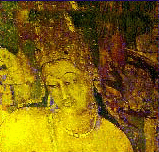| Murals |
 |
| During the 4th century AD. in a remote valley in Western India, work began on the Ajanta caves to create a complex of Buddhist monasteries and prayer halls. The sculptor-monks who lived here during the months of rain also took up a novel exercise of painting large tempera murals on the walls of the caves. The walls and ceilings were painted with frescoes in vibrant mineral colours. These paintings turned out to be of a quality which has never been surpassed. |
 |
The themes of these wall-paintings range from Buddhist legends to decorative patterns of flowers and animals. They seek to depict permanent human values and principles and are also records of the social texture of the times. The Golden Age of India under the Mauryan Empire was marked by luxurious living and splendour. The Ajanta murals were painted during this time of prosperity.
These murals also formed the basis of an entire aesthetic tradition which later spread to other countries in Asia.
|
| Versatility of line and form and role of color and composition are the endearing features of this art form. These paintings create a feeling of gaiety, wonder and resonance in the beholder. The viewer is transported into another state of consciousness where sound and light and colour and palpable form are fused into one separate reality. |
|
|
| Featured Paintings Gallery - Madhubani |
|
|
|
